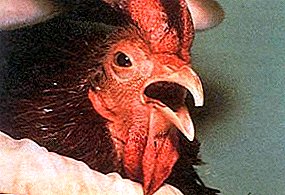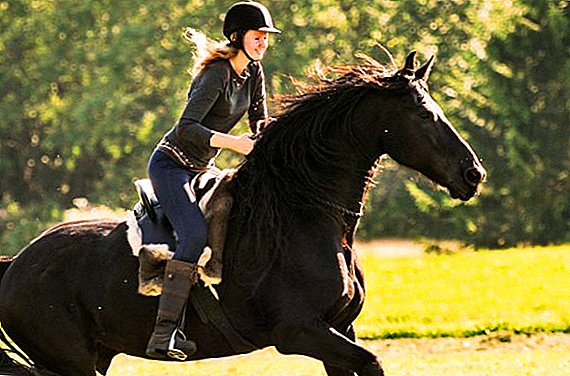
Breeding and maintenance of chickens is a profitable and interesting business. But the poultry industry has its own problems, in particular, diseases of birds.
Domestic chickens, as well as other creatures, are subject to various diseases and illnesses.
Infectious diseases are especially dangerous, in particular, infectious laryngotracheitis - a serious viral respiratory disease.
With laryngotracheitis in chickens, the trachea and larynx mucosa, the nasal cavity, and the conjunctiva are affected.
If the problem is not solved in time, in a short time the entire population of birds will be covered by the disease. Laryngotracheitis is caused by a filtering virus.
Infection occurs through the sick and recovered individuals. All types of chickens, pigeons, turkeys, pheasants are susceptible to the disease. More often infected with chickens.
Sick bird carries a virus up to 2 years. The spread of laryngotracheitis is due to poor conditions of keeping birds: poor ventilation, crowding, dampness, poor diet.
What is infectious laryngotracheitis chickens?
 For the first time laryngotracheitis was registered in 1924 in the United States. American researchers May and Titsler described it in 1925 and called it laryngotracheitis.
For the first time laryngotracheitis was registered in 1924 in the United States. American researchers May and Titsler described it in 1925 and called it laryngotracheitis.
The disease was later described as infectious bronchitis. After the 1930s, laryngotracheitis and infectious bronchitis were recognized as independent diseases.
In 1931, the disease of the larynx and trachea was proposed to be called infectious laryngotracheitis.
With this proposal made in the Committee on the diseases of birds. By that time, the disease had spread everywhere, including in the USSR.
In our country, infectious laryngotracheitis was first described in 1932 by R.T. Botakov. Then he called the disease infectious bronchitis. A few years later, other scientists described the disease under the modern name.
Pathogens
 The causative agent of laryngotracheitis is a virus of the family Herpesviridaehaving a spherical shape.
The causative agent of laryngotracheitis is a virus of the family Herpesviridaehaving a spherical shape.
Its diameter is 87-97 nm. This virus can hardly be called persistent.
For example, if there are no chickens in the house, he dies in 5-9 days.
In drinking water, the virus persists for no more than 1 day. Freezing and drying it canned, and when exposed to sunlight, the virus dies in 7 hours.
Alkali solutions of kerazole neutralize the virus in 20 seconds. On the shell of eggs, it can last up to 96 hours. Without sanitation, it penetrates into the egg and remains virulent for up to 14 days.
Up to 19 months, the herpes virus remains active in frozen carcasses and up to 154 days in cereal feeds and feathers. In the cold season, the virus lives in the open air for up to 80 days, indoors for up to 15 days.
Symptoms and forms of the disease
 The main sources of the virus are sick and ill birds.
The main sources of the virus are sick and ill birds.
The latter do not get sick after treatment, but 2 years after the illness are dangerous because they secrete a virus into the external environment.
Infection occurs through infected air.
The disease also spreads with slaughter products, feed, packaging, feathers and down.
In this case, the infection of the entire livestock occurs as soon as possible. More often the disease spreads in summer and autumn.
The course and symptoms of laryngotracheitis in chickens depend on the form of the disease, the clinical picture, the conditions of the birds.
The incubation period of laryngotracheitis is from 2 days to 1 month. Let us consider in more detail the main symptoms of the disease in each of the three forms.
Super sharp
 Often occurs where the disease has not previously manifested. When a highly virulent infection enters the medium up to 80% of chickens can be infected in 2 days.
Often occurs where the disease has not previously manifested. When a highly virulent infection enters the medium up to 80% of chickens can be infected in 2 days.
After infection, the birds begin to breathe with difficulty, greedily swallow air, pulling the body and head.
Some chickens have a strong cough, accompanied by blood swallowing.
Because of the choking roll, the chicken shakes its head, trying to improve its condition.
In the house where the sick chickens are kept, tracheal discharge can be seen on the wall and floor. The birds themselves behave passively, more often they stand in solitude, they shut their eyes.
The course of hyperacute laryngotracheitis is accompanied by characteristic wheezing, which is especially audible at night.
If the poultry farmers do not take action, after a couple of days the diseases of the chicken begin to die one after another. Mortality is high - more than 50%.
Sharp
 In acute form, the disease does not begin as suddenly as in the previous form.
In acute form, the disease does not begin as suddenly as in the previous form.
First, several chickens get sick, in a few days - others. Sick bird does not eat, all the time sitting with eyes closed.
The hosts note lethargy and general oppression.
If you listen to her breathing in the evening, you can hear not typical for healthy birds grunting, whistling or wheezing sounds.
She has a laryngeal blockage, which leads to respiratory failure and breathing through the beak.
If in the area of the larynx to hold palpation, it will cause her strong cough. Inspection of the beak will allow you to see hyperemia and swelling of the mucous membranes. On the larynx white spots can be seen - cheesy discharge.
Timely removal of these secretions can help save the life of chickens. After 21-28 days of illness, the rest may die from asphyxia due to blockage of the trachea or larynx.
Chronic
This form of laryngotracheitis is often an acute sequel. The disease is slow, characteristic symptoms occur before the death of the birds. From 2 to 15% of birds die. People can also infect a bird with this form due to unsuccessful vaccination.
Often there is a conjunctive form of laryngotracheitis, in which the eyes and mucous membrane of the nose are affected in birds.
It is more common in young animals up to 40 days of age. With this form of the disease, the chinks in the chickens are deformed, the eye photophobia begins, and they try to hide in a dark corner.
With a mild form, chicks recover, but they may lose their sight.
Diagnostics
 The disease is confirmed after opening and conducting laboratory tests.
The disease is confirmed after opening and conducting laboratory tests.
To conduct a virological study, fresh corpses, exudate from the trachea of dead birds, as well as sick birds are sent to specialists in the laboratory.
They isolate the virus in chicken embryos and carry out subsequent identification.
A bioassay on susceptible chickens is also used.
In the process of diagnosis, diseases such as Newcastle disease, respiratory mycoplasmosis, smallpox, and infectious bronchitis are excluded.
Treatment
 Once the disease is diagnosed, it is necessary to take for treatment.
Once the disease is diagnosed, it is necessary to take for treatment.
There are no special drugs for laryngotracheitis, but symptomatic treatment can help sick birds.
You can use antibiotics to reduce the activity of the virus and biomitsin to reduce mortality in chickens.
Also for the treatment of infectious laryngotracheitis chickens, like other birds, veterinarians use streptomycin and trivitwhich are administered intramuscularly.
Together with food, it is recommended to give furazolidin: for adults at the rate of 20 mg per 1 kg of body weight, for young animals - 15 mg per 1 kg of body weight. In the diet of chickens, it is important to include vitamins A and E, which dissolve fat cells.
Prevention
 Prevent illness can be a variety of ways. First of all, it is necessary to periodically disinfect the premises in which birds live.
Prevent illness can be a variety of ways. First of all, it is necessary to periodically disinfect the premises in which birds live.
However, they should be there. For disinfection recommended mixtures of drugs chlorine-turpentine, aerosols containing lactic acid.
Secondly, vaccination can be used. In regions with frequent outbreaks of the disease, live vaccine is administered to the birds through the nasal passages and infraorbital sinuses.
There is a probability that under certain conditions, these birds can become active carriers of the virus, so this measure is only a point of prevention.
The vaccine can be rubbed into the feathers of birds or injected into the water for drinking.
There is a vaccine specially developed for chickens from the strain "VNIIBP". Usually, chicks are vaccinated from 25 days of age, taking into account the epizootological situation.
If the economy is prosperous, aerosol vaccination is carried out. The vaccine is diluted according to the instructions and sprayed in the habitat of birds.
After this, a temporary deterioration in the condition of the birds is possible, which disappears after 10 days. The resulting immunity is maintained for six months.
Another vaccination option - cloaca. With the help of special tools, the virus is applied to the mucous membrane of the cloaca and rubbed in for some time. After a few days, the procedure is repeated. After vaccination, the mucous membrane is inflamed, but after that a strong immunity is produced.
If the disease manifests itself in one house, all chickens are sent to a sanitary slaughter, after which the room is disinfected and biothermal disinfection is carried out. In poultry farms entry and exit of people from the territory is allowed after careful sanitization of shoes.
 One of the less common birds is the Tsarskoye Selo breed of chickens. Learn more about her!
One of the less common birds is the Tsarskoye Selo breed of chickens. Learn more about her!You can conduct alternative electricity for a private house. All details are available at: //selo.guru/stroitelstvo/sovetu/kak-podklyuchit-elekstrichestvo.html.
Thus, laryngotracheitis is a dangerous infectious disease of chickens that every poultry farmer should be aware of. By recognizing the disease in time, it is possible to save the hens from suffering and premature death.












